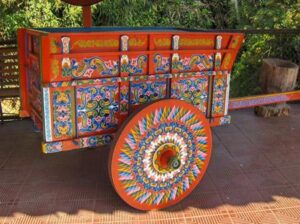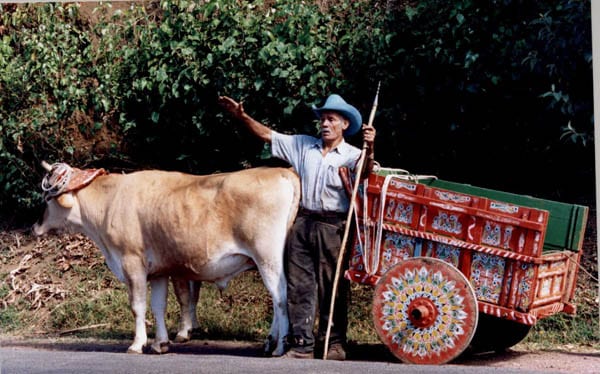Oxcart Day in Guanacaste, Costa Rica

Boyeros on Parade
In the heart of Guanacaste, Costa Rica, where rolling plains meet volcanic landscapes, a unique cultural celebration takes place every March—Oxcart Day or Día Nacional del Boyeros. While the most famous national celebration occurs in San Antonio de Escazú, Guanacaste embraces this tradition as well, paying homage to the boyeros (oxcart drivers) and their enduring legacy.
For centuries, the oxcart (carreta) was a vital tool in Costa Rica’s agricultural and economic development, used to transport coffee, sugarcane, and goods across rugged terrain. Today, this iconic symbol is celebrated with vibrant parades, traditional music, artisan craftsmanship, and a deep sense of pride that resonates through the Guanacaste region.
A Legacy Carved in Wood and Paint
The oxcart is more than just a means of transport—it is a work of art and a symbol of Costa Rican identity. In Guanacaste, master artisans keep the tradition alive, carefully painting intricate designs on the wooden wheels. The bright reds, blues, and yellows are not just for aesthetics; they tell the story of Guanacaste’s indigenous and colonial past.
The oxcart tradition in Costa Rica has even been recognized by UNESCO as Intangible Cultural Heritage, marking it as an invaluable piece of world history. For locals in Guanacaste, March is the time to honor this heritage through grand processions of oxcarts, oxen, and boyeros, all adorned in traditional attire.
The Festivities Begin
The Día Nacional del Boyero falls on the second Sunday of March, and in Guanacaste, it is often celebrated alongside the region’s famous fiestas cívicas (civic festivals).
Morning Procession: The Parade of Oxcarts
The day begins with dozens of elaborately painted oxcarts making their way through the streets of Liberia, Santa Cruz, or Nicoya—the towns most known for honoring this tradition. Tourists and locals line the roads, eagerly awaiting the sight of magnificent oxen teams pulling the handcrafted carts, their handlers guiding them with expert precision.
Each boyero (oxcart driver) wears traditional white shirts, wide-brimmed hats, and red bandanas, a tribute to Costa Rica’s rural past. Many of them have inherited the craft from their fathers and grandfathers, continuing a tradition passed down through generations.
Spectators cheer as the oxen, decked in colorful ribbons and bells, march proudly, their strength symbolizing the resilience of Costa Rican farmers. The rhythmic clatter of wooden wheels against cobblestone streets echoes the sounds of history, transporting everyone back to a time when these carts were the backbone of the economy.
A Symphony of Tradition
As the parade progresses, the sounds of Costa Rica’s folk music fill the air. The distinctive marimba, an instrument synonymous with Guanacaste, sets the rhythm for traditional dances performed by men and women dressed in flowing skirts and embroidered shirts.
The most beloved dance, El Punto Guanacasteco, sees performers move in elegant, sweeping motions, telling the story of courtship and rural life. The zapateado (stomping dance) adds excitement as dancers energetically pound the ground, creating a lively atmosphere.
For tourists, this is the perfect opportunity to join in the fun, as many locals welcome visitors to dance and experience Costa Rican hospitality firsthand.
The Artisan’s Market: A Showcase of Guanacaste’s Craftsmanship
No Oxcart Day celebration is complete without a visit to the artisan’s market. In Guanacaste, the town squares transform into colorful open-air markets, offering handcrafted goods that reflect the region’s deep cultural roots.
What to Find in the Artisan’s Market:
1. Miniature Oxcarts – Beautifully hand-painted souvenirs that tourists can take home.
2. Chorotega Pottery – Unique ceramics made using pre-Columbian indigenous techniques.
3. Leather Goods – Guanacaste is known for its high-quality saddles, boots, and belts.
4. Handwoven Hats and Baskets – Made from natural fibers, showcasing traditional craftsmanship.
Many of these items are created by artisans whose families have practiced these skills for centuries, making each piece a living testament to Costa Rica’s heritage.
The Flavors of Guanacaste
As the day continues, the aroma of traditional Costa Rican food fills the air. Oxcart Day is not just about history—it’s also a celebration of flavors.
Must-Try Dishes:
• Casado – A hearty meal of rice, black beans, plantains, salad, and choice of meat.
• Chicharrones – Crispy fried pork, a local favorite.
• Olla de Carne – A rich beef and vegetable stew, perfect for fueling up for the festivities.
• Chorreadas – Sweet or savory corn pancakes, often served with sour cream.
To wash it all down, visitors sip on fresh tropical juices, local coffee, or guaro cocktails (a sugarcane-based liquor).
The Evening Celebrations: Rodeos and Fireworks
As the sun begins to set, the energy shifts toward the rodeo arena, where the town’s best sabaneros (cowboys) showcase their skills in a thrilling bull-riding competition.
Unlike in Spanish bullfighting, Costa Rica’s rodeos focus on horsemanship and courage, ensuring that the animals are never harmed. The crowd roars as daring riders attempt to stay on bucking bulls for as long as possible.
Following the rodeo, a grand fireworks display lights up the sky, reflecting off the rooftops of Guanacaste’s colonial buildings. The celebration ends with a community dance, where families, tourists, and locals come together to revel in the joyous occasion.
Why Tourists Should Experience Oxcart Day in Guanacaste
For travelers seeking an authentic cultural experience, Oxcart Day in Guanacaste is a must-see event. Here’s why:
1. Deep Cultural Connection – Witness a UNESCO-recognized tradition that showcases Costa Rica’s agricultural and artistic history.
2. Unforgettable Scenery – Celebrate in the breathtaking landscapes of Guanacaste, with its rolling fields and towering volcanoes.
3. Warm Local Hospitality – Experience the legendary “pura vida” lifestyle, as locals invite visitors to dance, eat, and celebrate together.
4. Perfect for Families – The festival offers activities for all ages, from historical parades to thrilling rodeo action.
5. Great for Photography – The colorful oxcarts, traditional clothing, and lively performances provide incredible photo opportunities.
Conclusion: A Celebration That Stands the Test of Time
Oxcart Day in Guanacaste is more than just a festival; it is a living tribute to Costa Rica’s rural heritage, resilience, and artistic brilliance. Whether you’re a history buff, a cultural enthusiast, or simply a traveler in search of an unforgettable experience, this celebration offers a deep connection to the soul of Costa Rica.
As you stand in the midst of the parade, watching the oxen pull their magnificent carts and feeling the ground shake with the rhythms of traditional dance, you understand that this is not just an event—it’s a legacy, passed down from generation to generation.
So, if you find yourself in Costa Rica in March, head to Guanacaste, embrace the spirit of the boyero, and celebrate the glorious tradition of Oxcart Day.




